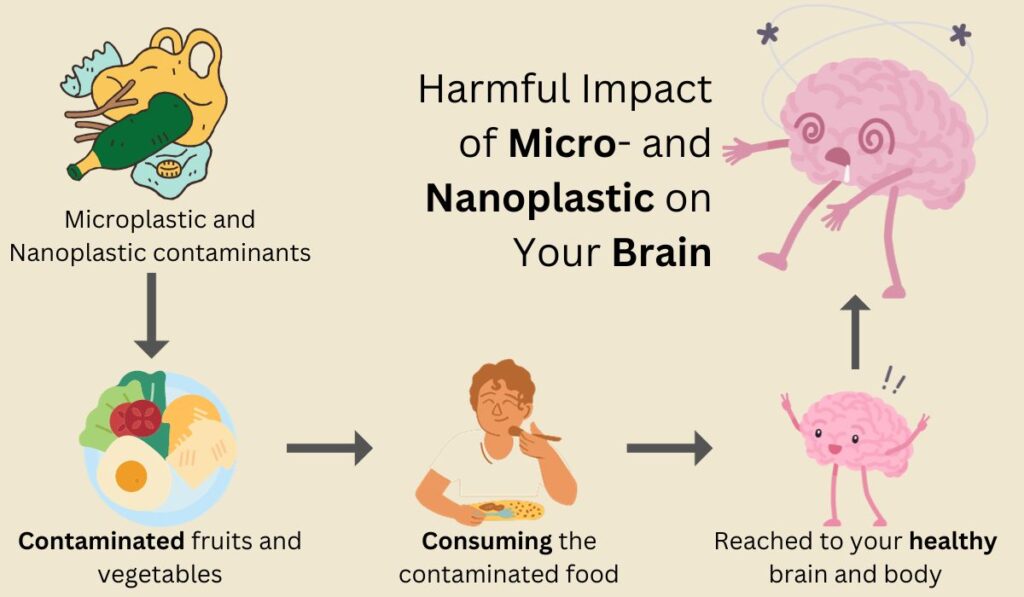Plastic is a synthetic polymer that has almost become a comfortable lifestyle partner in human life. We always failed to convince ourselves to avoid the use of plastic. The spectrum of plastic has a wide range, on which humans drive back and forth. From kitchen appliances to drinking, from a plastic bottle to texting someone all around us, we are all concerned with the matter of plastic. Though plastic has made lifestyle happy-go-lucky if you rotate your eyeball, you will say, ‘Is that really me and others that are always with the plastic? And we very well know about it.
Current evidence states that microplastics and nanoplastics can reach the brain and can harm the brain. In this article, we will look through the guide on the nature of microplastics to see how microplastics harm human lives and others.

The Micro World of Plastic
Microplastics are defined as “synthetic solid particles or polymeric matrices, with regular or irregular shape and with size ranging from 1μm to 5mm, of either primary or secondary manufacturing origin, which are insoluble in water. According to the European Chemicals Agency and the U.S. National Oceanic and Atmospheric Administration (NOAA), microplastics are particles of any kind of plastic that measure fewer than 5 mm (0.20 in) in length. The term “microplastics” was introduced in 2004 by Professor Richard Thompson, a marine biologist at the University of Plymouth in the United Kingdom.
The Nature And Exposure of Microplastic
Microplastics pose serious risks to the environment and human life. The particle size, weight, and concentration vary with the products or materials used in manufacturing textiles, electronics, single-use plastics, and others. Some types of microplastics are a result of the combination of hazardous chemicals that quite unknowingly cooperate with our lifestyle. Sometimes, without the systematic treatment of plastics, they are dumped in landfills or directly in water bodies. Two different types of chemicals can be identified in microplastics: (i) chemicals absorbed from their surroundings, and (ii) additives and polymeric raw materials (such as monomers or oligomers) coming from the plastics. Sometimes microplastics are purposefully manufactured and produced by various sectors, such as dyes, paints, medicines and drugs, and cosmetics. These never-ending factors and benefits make them still go with the flow.

A recent report by the World Health Organization highlighted the ubiquity of microplastics in the environment and raised major concerns about the exposure to and impact of nano- and microplastics on human health. One of the most important entry points for nanoplastics and microplastics into the human body is the ingestion of contaminated food.
What Researchers Talk About Micro- And Nanoplastic?
A recent study detected 0.44 MP/g of nano- and microplastics in sugar, 0.11 MP/g in salt, 0.03 MP/g in alcohol, and 0.09 MP/g in bottled water. Humans may also be expected to consume an estimated 80 g of microplastics per day through plants (fruits and vegetables) that accumulate their MPs by consumption from contaminated soil.
MUST READ: Microplastics in Fruits and Vegetables: Health Risk and Ways to Prevent
Can Microplastic Harm the Body and Brain?
Studies indicate that microplastics, nanoplastics, and plastic debris have a harmful impact on mammals, aquatic life, and marine life. Regular exposure to oxidated, harmful chemicals leads to stress, cellular dysfunction, neural dysfunction, and the development of mental disorders. Researchers also detected microplastics present in the human gut, placenta, intestine, bloodstream, airway, etc.
The invasion of microplastics will lead to malfunctioning of the digestive system, respiratory system, and neural system. Toxins affecting nerve tissue are known as neurotoxins (producing neurotoxicity). Neurotoxins prevent neurons from communicating across synapses or controlling ion concentrations across the cell membrane. Glial cell injury is one type of local neurotoxic exposure disease that can also include neuron excitotoxicity.
Effects of Microplastic on the Brain
The brain has evolved through this period of evolution and makes humans different individuals from others. The brain is developed in such an organized form to perform specific functions from specific regions that work interdependently with each other. This ability of the brain comprises performing physical and motor functions and regulating and observing humans’ thoughts and actions. The overdependency of plastics has led to multiple problems. Plastics are directly consumed by our bodies, damaging our neural responses. The concern is about the physical and mental health of humans.
A group of researchers headed by the University of Rhode Island, Professor Jaime Ross set out to investigate the possible health effects of microplastic exposure on mammals. The research was particularly concerned with the impacts on neurobehavior, inflammatory reactions, and tissue accumulation. The findings imply that exposure to microplastics in mammals—including humans—poses a severe health risk. The researchers discovered a possible connection to Alzheimer’s among other issues.
Over three weeks, Ross and her study team exposed young and old mice to different concentrations of microplastics in their drinking water. The researchers discovered that the test subject’s exposure to microplastics changed the immunological markers in their liver and brain tissues as well as their behavior. Remarkably, the mice started acting like people with dementia; the effects were stronger in older mice.
The Long-Term Impact of Micro- And Nanoplastic on the Human Brain
Micro- and nanoplastic exposure can have enduring consequences on the brain, such as neurotoxicity, modified behavioral patterns, reduced brain mass, cognitive alterations, and the particles’ tendency to pass through the blood-brain barrier. Evidence from research indicates that the existence of polystyrene micro- and nanoparticles in the brain is accompanied by modifications in behavioral patterns, reduced brain mass, and variations in certain proteins. These changes may be linked to neurodegenerative disorders including Alzheimer’s and Parkinson’s. In addition, being exposed to these particles can result in the suppression of acetylcholinesterase activity, which could potentially be a factor in the observed alterations in behavior. Moreover, research has demonstrated that micro- and nanoplastics might provoke modified transmission in the brain and impair the brain’s capacity to sustain its functions. Additionally, the research indicates that these particles have the ability to accumulate in the brain and impact the formation of neuronal pathways. Additional research is required to have a comprehensive understanding of the prolonged consequences, although current evidence suggests that exposure to micro- and nanoplastics may have adverse impacts on the brain.
The Bottom Line
Though the studies on microplastics on the human body and brain are still limited, they also open up the possibility of outcomes and raise questions about whether microplastics are harmful, and whether they can affect human cognition and other mental processes. One should understand the long-term effects of microplastics on human, mammal, aquatic, and marine life.
The environment we are serving for future generations is a matter of concern. The security and sustainable development of natural resources are our responsibility. For the betterment of human resources, it is our responsibility to take care because our health, security, and safety are in our hands.
References:
- Frias J., Nash R. Microplastics: Finding a Consensus on the Definition] Mar. Pollut. Bull. 2018; 138:145–147. doi: 10.1016/j.marpolbul.2018.11.022.
- Microplastic waste: This massive (tiny) threat to sea life is now in every ocean”. The Independent, July 13, 2014.
- Cox K.D., Covernton G.A., Davies H.L., Dower J.F., Juanes F., Dudas S.E. Human Consumption of Microplastics. Environ. Sci. Technol. 2019; 53:7068–7074. doi: 10.1021/acs.est.9b01517.
- https://particleandfibretoxicology.biomedcentral.com/articles/10.1186/s12989-020-00358-y
- https://ryaninstitute.uri.edu/microplastics/
- https://www.ncbi.nlm.nih.gov/pmc/articles/PMC7282048/
- https://www.theguardian.com/commentisfree/2023/may/01/plastic-is-already-in-blood-breast-milk-and-placentas-now-it-may-be-in-our-brains
- https://www.sciencedirect.com/science/article/abs/pii/S0304389422006732

This is an eye-opening read. It’s alarming to see how microplastics and nanoplastics can impact brain health. Thank you for shedding light on such a critical issue. More awareness and research are definitely needed
Very informative